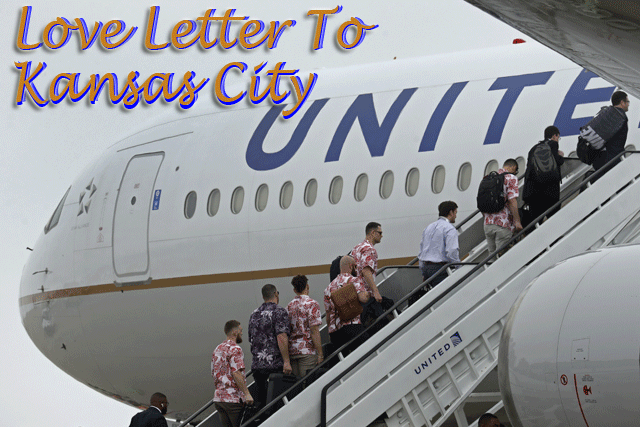
Kansas City Chiefs Super Bowl Champions fly first class from Miami
to Kansas City celebration.
|
Dear Readers,
We have been at this beat covering air cargo
for the past 46 years.
During that time we have received and shared
letters with you.
Here is a great letter, a short story really,
that dips into the business of air cargo, but also brings forward and
shares the heart, emotion and passion of a long time FlyingTypers
reader.
The celebration of Kansas City, Missouri,
home of the 2020 Super Bowl winners, the Kansas City Chiefs, is a unique
step-by-step look at a great American city.
The constant look up the facts “click
bait” here emulates much of the activity we have noticed when talking
to an audience, or trying to recall a famous quote around the dinner table
at home with our children.
The letter by Landrum & Brown’s
resident air cargo expert Michael Webber is poetry in motion; an unabashed
love affair, direct from the heart and so much fun to read.
Our Valentine to you, dear reader.
We hope that you enjoy the read and the
ride.
Geoffrey
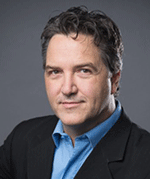 Dear
Geoffrey & Sabiha, Dear
Geoffrey & Sabiha,
I so enjoyed your celebration of
the Kansas City Chiefs’ Super Bowl victory, as well as your appreciation
of Kansas City jazz. While I have lived elsewhere more years than I’ve
lived in my hometown of Kansas City, KC shaped me in ways that can even
still surprise me more than 55 years since my birth there.
Kansas City As A Distribution Gateway:
THEN
The Kansas City metropolitan area
arose at the confluence of the Kansas and Missouri rivers where Native
Americans traded long before Euro-American settlement. The Lewis and Clark
Expedition reached the area in 1804 and by the 1820’s, the area
was populated by trappers, scouts, traders and farmers. The trading post
known as “West Port” was fed by river and provided the last
supply depot for pioneers entering the Kansas Territory on the California,
Santa Fe and Oregon Trails.
Rail arrived at the Town of Kansas
in 1847 but further expansion was stalled by border fighting that would
escalate into America’s Civil War. After the Kansas-Nebraska Act
overturned the Missouri Compromise’s reliance on latitude to determine
slavery’s expansion, “Bleeding Kansas” became the firewall
and the fledgling Kansas City a critical gateway into freedom for the
Underground Railroad.
At the conclusion of the Civil
War in 1865, the Missouri Pacific Railroad reached the area and the 1869
opening of the Hannibal Bridge over the Missouri River ensured that Kansas
City would overtake all regional rivals for trade supremacy.
A case study in how infrastructure
determined 19th century economic and population growth, Kansas City’s
population swelled from 1,500 when rail reached the area in 1847 to 130,000
in 1889. An excellent book on that subject is “Kansas
City and the Railroads: Community Policy in the Growth of a Regional Metropolis”
published by the University Press of Kansas in 1993.
NOW
The first time that this writer
boarded an aircraft was at the old Kansas City Downtown Airport (MKC),
located on 695 acres bordering the Missouri River. Fittingly, the airport
dedicated by Charles Lindbergh in 1927 ushered in the age of air transportation,
within close proximity to the Hannibal Bridge. It was here (specifically
at 10 Richards Road) where Howard Hughes officed when Kansas City was
TWA’s headquarters.
In 1972, MKC was replaced by Kansas
City International Airport (MCI), exchanging an almost downtown location
for a far more expansive setting fifteen miles northwest. Borrowing
from the template of the TWA Flight Center at JFK Airport, the horseshoe
terminals at MCI emphasized the proximity of cars to the gates but would
introduce new challenges as 1970’s hijackings brought security measures
for which MCI’s terminals were ill-suited. Eventually, TWA would
move its passenger hub to St. Louis. While TWA would eventually haunt
both cities, STL remains the larger passenger market with 15.6 million
passengers in 2018, compared with MCI’s 11.8 million. STL ranked
#38 among ACI-NA’s member airports for the year, compared with MCI’s
#45 ranking. After close to 50 years, MCI is finally losing the horseshoe
terminals in favor of a more efficient single-terminal design.
In spite of Kansas City’s
smaller metro population and annual passenger counts, MCI consistently
leads all airports in the surrounding six-state area (Kansas, Missouri,
Iowa, Nebraska, Oklahoma and Arkansas) in terms of annual air cargo. In
2018, MCI accommodated 44% more air cargo tonnage than STL, which was
actually the third-largest cargo airport in the region – also trailing
Omaha’s Eppley Airfield. Little Rock (LIT) does not report cargo
data to ACI-NA but would rank around #85, based on 2018 data reported
to the FAA.
ACI
Rank |
Airport |
2000 |
2018 |
% Growth |
41 |
Kansas City (MCI) |
150,583 |
96,303 |
-36% |
53 |
Omaha (OMA) |
114,268 |
69,941 |
-39% |
57 |
St. Louis (STL) |
130,152 |
66,998 |
-49% |
60 |
Tulsa (TUL) |
54,111 |
59,385 |
10% |
75 |
Des Moines (DSM) |
112,511 |
31,879 |
-72% |
80 |
Oklahoma City (OKC) |
51,954 |
29,220 |
-44% |
84 |
Wichita (ICT) |
25,648 |
24,581 |
-4% |
93 |
Springfield, MO (SGF) |
12,087 |
13,887 |
15% |
Group |
|
651,314 |
392,194 |
-40% |
| Data
Source: Airports Council International – North America |
No airport in the six-state region topped 100,000
metric tons in 2018. Most endured double-digit percentage losses since
their peak year (2000). Des Moines (DSM) experienced the closing of what
had been a substantial regional operation for UPS but otherwise the airports’
losses were typical of U.S. airports in general for the period –
especially those that are not international gateways and major integrator
hubs. The central geographic locations of Kansas City, Omaha and St. Louis
made them natural crossroads for surface transportation like trucking
and rail, but the lack of surrounding feeder markets made them less appealing
as air cargo hubs.
From that perspective, Kansas City’s cargo
dominance in its region begs an explanation. While the Kansas City metro
area has a smaller population than St. Louis, its industry has proven
more conducive to producing air cargo demand. Kansas City’s high-tech
and life sciences (animal pharmaceuticals having been particularly prolific)
industry not only produces time-sensitive, high-value commodities but
supports a relatively prosperous citizenry. Of course, the Kansas City
metro area is still a major distribution center for rail and truck –
home to the Kansas City Southern Railway and to YRC Worldwide –
remembered as Yellow Freight by many of us.
Contacted for this piece, the representatives
of the Kansas City Aviation Department indicated that very good news should
be expected within the year, regarding significant expansions by air cargo
operators but would not disclose more.
KANSAS CITY CULTURE THEN
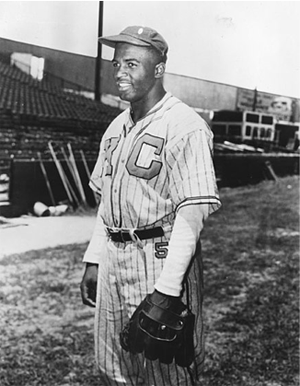 The antecedents that made Kansas City a crossroads for trade also made
it an iconic crossroads of 20th century American culture. It is no coincidence
that the Negro Leagues Baseball Museum and the American Jazz Museum are
side-by-side in KC’s 18th & Vine district. The Kansas City Monarchs
were the Negro League’s most iconic team – producing more
major league players, including Ernie Banks, Satchel Paige and Jackie
Robinson, pictured) than any other franchise.
The antecedents that made Kansas City a crossroads for trade also made
it an iconic crossroads of 20th century American culture. It is no coincidence
that the Negro Leagues Baseball Museum and the American Jazz Museum are
side-by-side in KC’s 18th & Vine district. The Kansas City Monarchs
were the Negro League’s most iconic team – producing more
major league players, including Ernie Banks, Satchel Paige and Jackie
Robinson, pictured) than any other franchise.
That history with baseball’s Kansas City
Monarchs leads seamlessly into the Kansas City Chiefs’ pioneering
role in fully integrating pro football. Chiefs’ owner (and AFL founder)
Lamar Hunt and 1960’s coach Hank Stram have likely never received
the credit deserved for that role. Author of the book “Mavericks,
Money and Men: The AFL, Black Players, and the Evolution of Modern Football”,
Dr. Charles K. Ross, chair of the African-American Studies program at
the University of Mississippi states “it would be fair to say that
Lamar Hunt, in many ways, was the Branch Rickey of the AFL.”
The Kansas City Chiefs of the AFL had more HBCU
(Historically Black Colleges & Universities) players than any other
team in the NFL or AFL. The 1969 Chiefs team that won Super Bowl IV had
13 HBCU players on its 44-man roster and its starting roster featured
12 African-Americans among its 22 starters – a majority that had
never happened in a championship game. The Vikings team annihilated by
those Chiefs had zero HBCU players on its roster. While the Jets’
victory over the Colts in the preceding Super Bowl announced that the
AFL had arrived as a competing league, the Chiefs’ dominant victory
delivered its own message.
Here are links
to clips about the relationship between the Chiefs’ legendary defensive
captain Willie Lanier and Jim Lynch, as well as a fuller treatment of
that Chiefs team and HBCUs. Further coverage
here.
One more unusual wrinkle about that era of the
Chiefs but also an informative insight into Hank Stram comes from this
clip
featuring actor John Amos, recalling his days in training camp with the
Chiefs and how Stram saw the complete man and not just the athlete.
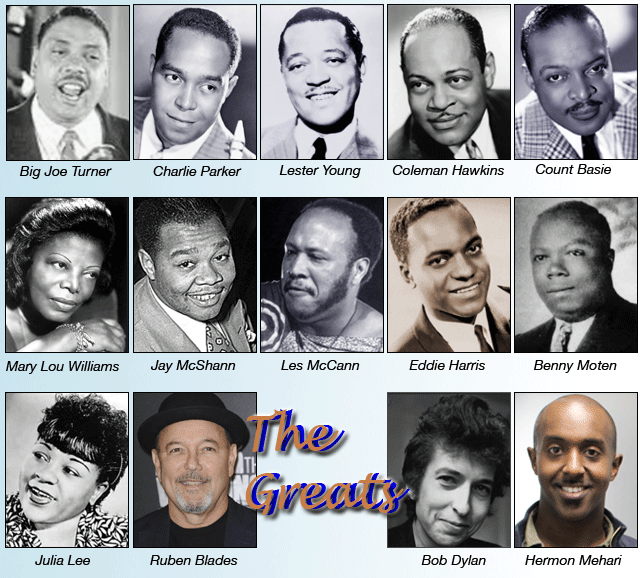 |
All of this, Geoffrey, and I have barely touched
upon KC’s contributions to American music – perhaps my favorite
manifestation of KC as a crossroads. While Jazz rightly gets the lion’s
share of attention, let us pause for a moment to appreciate Kansas City,
Missouri’s Big
Joe Turner, about whom Doc Pomus claimed “Rock and roll would
have never happened without him.”
As to Kansas City Jazz, accounts of the cutting
contest between Lester Young and Coleman Hawkins collects in one anecdote
such a vivid characterization of the Kansas City Jazz scene and its main
players.
Whether artists were actually born in the area
– like Charlie Parker in Kansas City, KS and Coleman Hawkins in
St. Joseph, Missouri – or migrated there like Jay McShann, Lester
Young and Count Basie – they shaped Kansas City Jazz and were shaped
by it.
Enjoy Lester Young and Charlie Parker – among others – on
this 1949 recording of “Lester
Leaps In.”
The Jay McShann Orchestra (including Charlie
Parker) on this 1941 recording of “Hootie
Blues.”
The wonderful Mary Lou Williams and Her Kansas
City Seven on this 1940 recording of “Baby
Dear.”
And of course, Benny Moten’s Kansas City
Orchestra, featuring Count
Basie.
Let’s not forget one of my personal favorites among Kansas City’s
roster of artists, the daringly bawdy Julia
Lee.
While not a Kansas Citian, Bob Dylan has mentioned
Kansas City in a surprising number of songs, often mythologizing the city
into more of a concept than a geographical place. An example comes from
one of my favorite Dylan songs, “High Water (For Charley Patton).”
“High water risin’ – risin’ night and
day
All the gold and silver are bein’ stolen away
Big Joe Turner lookin’ east and west
From the dark room of his mind
He made it to Kansas City
Twelfth Street and Vine
Nothin’ standing there
High water everywhere” |
Let’s wrap this look back with native Kansas
Citian Gene McDaniels’ classic “Compared
to What” – first made famous by Les McCann and Eddie Harris.
Oh, and nobody need worry that Kansas City’s
musical riches are strictly museum pieces. The KC metro continues to produce
a remarkable stream of musical talent, including the magnificent young trumpeter
Hermon
Mehari.
And what could better underscore Kansas City’s
continuing vibrancy as a cultural crossroads than the success of Latin Grammy
Award nominees Making Movies whose collaboration with Panamanian legend
Ruben
Blades turned a lot of heads last year.
Postscript Regarding Restaurants:
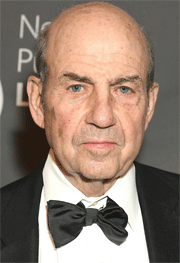 It is with a little humility that I dare dispense a few words about dining
in Kansas City. I have met America’s greatest combination food writer/humorist
Calvin Trillin (left) and I am no Calvin Trillin. Like Burt Bacharach,
Trillin is Kansas City-born but enough of a long-time New Yorker that
New Yorkers are amazed to learn they are not natives. It is a distinction
that allows Trillin to enjoy absurdities that native New Yorkers might
not recognize as absurd. Like most Kansas Citians (certainly the one writing
this), Trillin has sustained an urgency to make non-Kansas Citians aware
that Kansas City is the best because if we won’t, nobody will.
It is with a little humility that I dare dispense a few words about dining
in Kansas City. I have met America’s greatest combination food writer/humorist
Calvin Trillin (left) and I am no Calvin Trillin. Like Burt Bacharach,
Trillin is Kansas City-born but enough of a long-time New Yorker that
New Yorkers are amazed to learn they are not natives. It is a distinction
that allows Trillin to enjoy absurdities that native New Yorkers might
not recognize as absurd. Like most Kansas Citians (certainly the one writing
this), Trillin has sustained an urgency to make non-Kansas Citians aware
that Kansas City is the best because if we won’t, nobody will.
Trillin authored the food classic “opinion”
column “No! One of the World’s Foremost Authorities on Ribs,
Cheeseburgers, French Fries and Frosty Malts Takes A Gourmet Tour of Kansas
City” for Playboy magazine, opening with “The best restaurants
in the world are, of course, in Kansas City. Not all of them; only the
top four or five. Anyone who has visited Kansas City, Missouri, and still
doubts that statement has my sympathy: He never made it to the right places.”
Some of Trillin’s musings have not fared
so well. Trillin asserted that Kansas City’s venerable burger institution
Winstead’s made the best hamburger in the world – a claim
that for many years caused touring musicians to test the boast and often
leave satisfied in its veracity. Winstead’s is still open but is
not even the best burger joint in Kansas City, let alone the world but
then Pluto is no longer a planet either.
Sadly too, some of Kansas City’s most historic
steak joints – those old enough to have been favorites of native
son Harry S. Truman and the Pendergast Machine that made him – have
seen better days. One can still dine at a Hereford House or Golden Ox
but only for nostalgia’s sake – based on my last visits. A
restaurant called Savoy at 21c occupies the space long occupied by Kansas
City’s Savoy Grill where Truman and other presidents often dined.
Anyone on a scavenger hunt requiring eating at
all of the places favored by Trillin and companions like Fats Goldberg
(another Kansas City-born, New York legend) might feel obligated to visit
those institutions but I’ll recommend instead Pierpont’s,
which offers the bonus of being located inside of Kansas City’s
stunning Union Station rail hub where WWI draftees received their training
camp assignments and site of an infamous 1933 shootout – imaginatively
dubbed the Kansas City massacre – between FBI agents and mobsters
reputed to include Charles “Pretty Boy” Floyd.
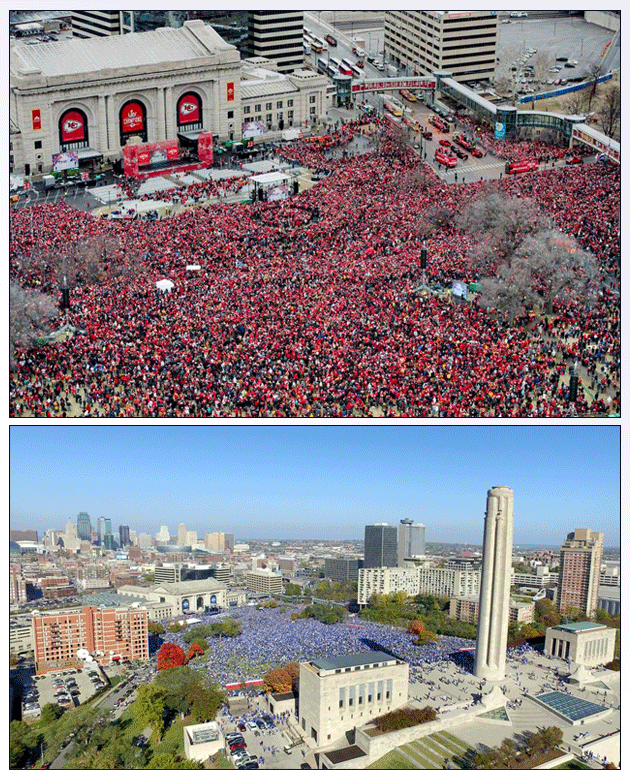
And a magnificent view of both Liberty Memorial and Union Station
during the Royals championship parade a few years ago. |
Union Station has calmed down but is still
breathtaking and rests across from the Liberty Memorial – the only
major monument to WWI finished before the outbreak of WWII and the home
of the National World War I Museum and Memorial. In recent years, Union
Station and the Liberty Memorial have served as spectacular backdrops
for parades celebrating the world champion Kansas City Royals and Kansas
City Chiefs.
By comparison, debates about politics or organized
religion might be less belligerent than arguing best barbecue restaurants
in Kansas City. So argumentative are the locals that one might warm up
by simply arguing whether one is about to eat barbecue, BBQ or Bar-B-Que.
I am that rarest of Kansas Citian who will admit to being able to enjoy
barbecue in establishments in Memphis and Texas. The whole of Texas has
at least 2 or 3 barbecue establishments that would rank in Kansas City’s
top twenty and one (Valentina’s) is near my current residence in
Southwest Austin. By Kansas City standards, these acknowledgements amount
to magnanimity.
For history’s sake, a visitor will need
to go to Arthur
Bryant’s – specifically, the one at 18th & Brooklyn
which is convenient for visiting the Jazz and Negro Leagues Museums at
18th & Vine. Visiting presidents and rock stars have their photos
taken there
to prove their American authenticity.
I am delighted to report that Arthur Bryant’s
is still as good as when Trillin wrote “It has long been acknowledged
that the single best restaurant in the world is Arthur Bryant’s
Barbeque at 18th and Brooklyn in Kansas City”. However, it is a
bizarre point of pride among some Kansas Citians that the best restaurant
in the world is not quite the best restaurant in Kansas City.
Or even the best barbecue restaurant in Kansas
City because that distinction belongs to LC’s Bar-B-Q on Blue Parkway
near the Harry S. Truman Sports Complex. More specifically, the burnt
ends at LC’s are the best thing served anywhere in the world and
at about $10.00, they’re the kind of bargain that Trillin theorized
was responsible for obesity in the metro area. Trillin has worried that
visiting New Yorkers – unaccustomed to such culinary bargains -
might gorge themselves to death like birds flocking upon a busted pallet
of birdseed. In my youth, my father and I would have a sandwich from LC’s
on our way to Royals and Chiefs games, then have burnt ends on the return
leg. No need to be excessive by having the same dish twice in a day.
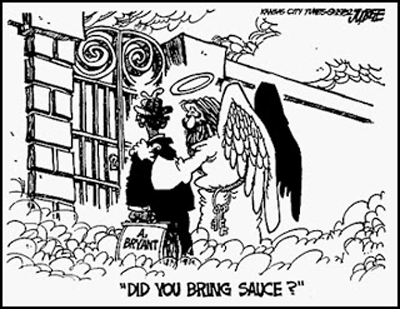 Kansas Citians often ask one another when we
meet in other cities “did you bring sauce?” When Arthur Bryant
passed away, the KC Star ran this loving cartoon. Perfect!
Kansas Citians often ask one another when we
meet in other cities “did you bring sauce?” When Arthur Bryant
passed away, the KC Star ran this loving cartoon. Perfect!
I no longer live in Kansas City but some day
will have my ashes spread there – ideally in the parking lot of
LC’s, although good taste probably compels it be at a distance from
the smokers. I keep informed enough to know that great restaurants have
opened since we’ve been gone. The Corvino Supper Club & Tasting
Room is on my list for next time.
Very near the Kansas City Star’s new building
– replacing the original where cub reporter Ernest Hemingway honed
his craft – is The Belfry (1532 Grand), operated by James Beard
award-winning chef Celina Tio – veteran of a variety of national
television cooking series (Top Chef Masters, Iron Chef America and the
Next Iron Chef) on which her celebrity judges have included none other
than actor Geoffrey Arend. The food is exquisite and its bar is my current
favorite during returns to my hometown.
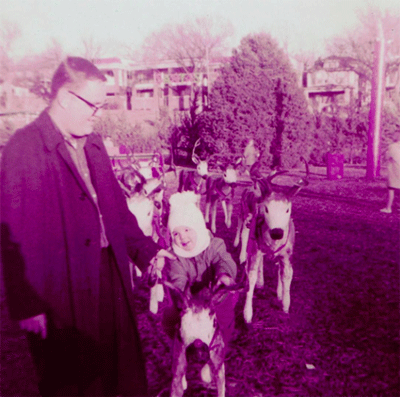 Your correspondent as a toddler with his father in Kansas City’s
Gilham Park. The events surrounding my birth in Kansas City seem almost
quaint now but will be familiar to some of my generation. In the early
1960’s, my father was stationed with the US Air Force’s Third
Air Force at RAF South Ruislip (a/k/a South Ruislip Air Station) and my
family lived off-base in nearby Pinner. Following the JFK assassination
in November 1963, many nonessential personnel and their families were
returned stateside, including my mother (approaching the third term of
pregnancy) and older siblings. Thus it was that in March 1964, I would
be born in Kansas City, Missouri instead of at a military hospital near
London.
Your correspondent as a toddler with his father in Kansas City’s
Gilham Park. The events surrounding my birth in Kansas City seem almost
quaint now but will be familiar to some of my generation. In the early
1960’s, my father was stationed with the US Air Force’s Third
Air Force at RAF South Ruislip (a/k/a South Ruislip Air Station) and my
family lived off-base in nearby Pinner. Following the JFK assassination
in November 1963, many nonessential personnel and their families were
returned stateside, including my mother (approaching the third term of
pregnancy) and older siblings. Thus it was that in March 1964, I would
be born in Kansas City, Missouri instead of at a military hospital near
London.
Love to you and Sabiha from us. Thanks for such
a beautiful diversion from contemplating airports’ cargo capacity.
Keep up the good work.
Every good wish,
Michael Webber
Associate Vice President
Landrum & Brown
Global Aviation Planning & Development
mwebber@landrum-brown.com
|




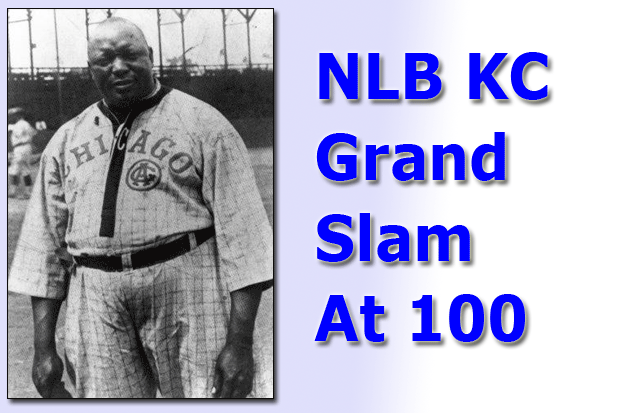
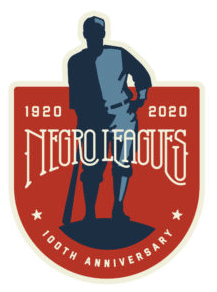 Andrew
“Rube” Foster, (above) Baseball Hall of Fame pitcher
(1981) and acknowledged ‘father of black baseball’ for his managerial
and executive skill in forming the league, and other team owners met at
what was once the Paseo YMCA at 18th and Vine in Kansas City.
Andrew
“Rube” Foster, (above) Baseball Hall of Fame pitcher
(1981) and acknowledged ‘father of black baseball’ for his managerial
and executive skill in forming the league, and other team owners met at
what was once the Paseo YMCA at 18th and Vine in Kansas City.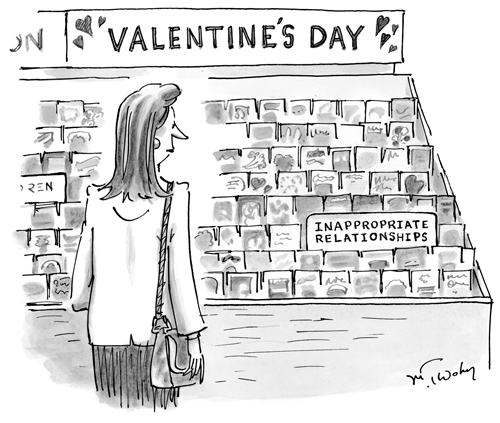

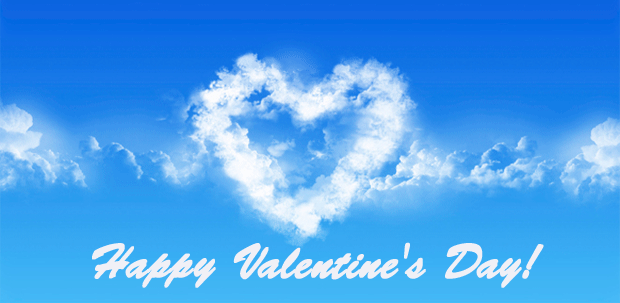
 Vol.
19 No. 8
Vol.
19 No. 8